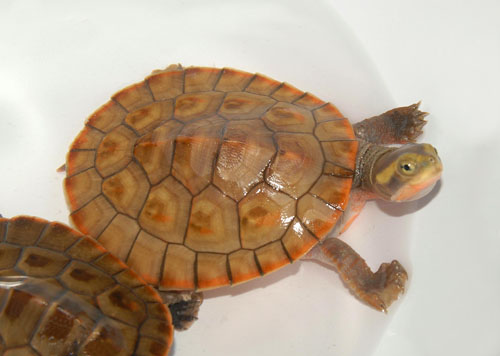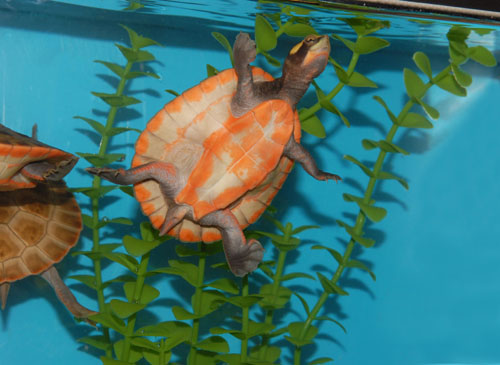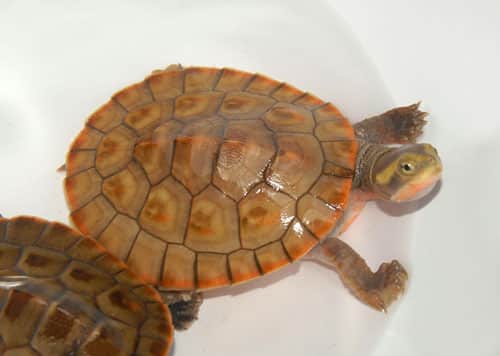Care sheet for the pink-bellied side-necked turtle Emydura subglobosa
The pink-bellied side-necked turtle (Emydura subglobosa) is a recent introduction to the North American turtle keeping hobby. Its shell ranges in color from beige to chestnut brown or slate gray. The plastron can be white, pink or, in the case of especially prized specimens, bright red/orange. The skin is typically various shades of gray, with some red markings. As pink-bellied side-necks grow, their skin develops additional random red/orange markings.
Read More
Breeder's Choice: hypo-pastel pink-bellied side-necked turtle
Keeping a Turtle? Here are Some Tips All New Turtlekeepers Need To Know

Photo courtesy The Turtle Source
Due to successful captive-breeding efforts, the pink-bellied side-necked turtle is not the extreme rarity it once was.
Hatchlings are born with an attractive white, yellow or orange ring at the outer edge of their marginal scutes (the outer shell, looking down from above). Their heads are gray to olive green with two bold yellow stripes on either side. The curved lower jaw gives this turtle a permanent smile.
Sex is easily determined. Males have longer, larger and thicker tails, and females have shorter, smaller and more narrow tails. These differences begin to show themselves when the turtles are about 3 1/2 inches in shell length, and are unmistakable when a turtle's shell reaches 5 1/2 inches.
Pink-Bellied Side-Necked Turtle Availability
Once the rarest of turtles in the United States, pink-bellied side-necks are now being bred successfully by several U.S. breeders to the point where the growing demand by U.S. keepers is met every year. The turtle is legal to keep in all U.S. states. It is one of the few that Oregon allows, and Hawaii allows them, too, but to keep them there requires special permit.
The success of American breeders with this species has enabled the turtle's price to drop dramatically in recent years. Well-started hatchlings usually start at about $79. If you want larger turtles to match others in your collection, or to keep in a large tank or pond, hand-raised yearlings or pink-bellies that are 2 to 3 years old may be priced in the $89 to $129 range.

Photo courtesy The Turtle Source
It's not hard to see how this attractive turtle came by its common name.
Pink-Bellied Side-Necked Turtle Size
An outstanding aquarium or pond turtle, hatchling pink-bellied side-necks emerge from their eggs at 1.25 inches and quickly grow another half an inch during their first few months. Then they grow a little over an inch a year if fed the same amounts as they would eat in nature. Keepers tend to feed more, however, so faster growth is often the case. After about 10 years, adults may grow up to 10 inches. Keep this in mind when choosing an enclosure.
Pink-Bellied Side-Necked Turtle Life Span
Because it is relatively new to turtle keeping at the time of this writing, this turtle's longevity over decades has not yet been documented. In 1999, I started with full-grown adults, and they look unchanged 12 years later. This suggests that a normal aquatic turtle life span of 30 to 50 years, or even longer, may be possible. As with nearly all turtle species, a stable environment is the key to long life.
Pink-Bellied Side-Necked Turtle Set Ups
Pink-bellied side-necked turtles are very adaptable. You can keep them in shallow water that's only a few times their shell length in depth to water that is as deep as you care to make it.
A glass aquarium with some depth will show off specimens' trademark pink bellies every time they head to the surface.
Hatchlings up to 4 inches in shell length can be kept in a 20-gallon aquarium or similarly sized container. As they grow, the tank's size should be increased by 10 gallons for every inch over 4 inches. Also increase the size of the enclosure by 10 percent (or more, if possible) for every additional turtle.
Ideal water temperature range is 66 to 80 degrees Fahrenheit. Hatchlings do well in the 70s to low 80s, but will become less active if water temps fall below 65 degrees. They do very well in moderately acidic, neutral, or mildly basic water. A bit of chlorine, and even small amounts of chloramines, do not bother this hearty species. If you're not sure what's in your water, use a dechlorinator. A good rule of thumb is if it's safe for you to drink, you can keep your pink-bellied side-necks in it.
Pink-bellied side-necked turtles will forage around and rest upon plastic plants, rocks and submerged logs. Avoid creating tight spaces in which they might get stuck. Except for American snappers and some of the larger musk turtles, this side-neck gets along with just about every other species of turtle.
Pink-Bellied Side-Necked Turtle Lighting and Temperature
A well-lit aquarium is always nicer for keepers, and it helps display the turtles. Though it's not required because E. subglobosa is not a basking turtle, UVB lighting couldn't hurt and may still provide some benefits. Basking surface temperatures in the low to mid 90s suits this species well. Providing both UVB light and a small, heated basking surface often requires two separate light fixtures; a single timer for both fixtures that matches the ambient lighting schedule in the room where you keep your turtle will make life very easy.
Pink-Bellied Side-Necked Turtle Diet
In the wild, this turtle is thought to feed on mollusks, crustaceans and aquatic insects. Juveniles enjoy high-protein diets. Our pink-bellied side-necks readily accept turtle pellets and cut fish or other seafood (though avoid shrimp) of any type. They will adjust to whatever reasonable feeding schedule you decide upon. We feed ours on Mondays, Wednesdays and Fridays.
Pink-Bellied Side-Necked Turtle Handling and Temperament
While pink-bellied side-necked turtles are a pleasure to keep, they should be handled sparingly. This is a highly aquatic species, which means the pink-bellied side-necked turtle is an excellent swimmer that feels most secure when it's in the water. In nature, when turtles are picked up, it's often because they are about to be eaten by a predator. So their instinct is to stay in the water as much as possible. With a little patience, though, your turtle will likely learn to feed from your hand.
Pink-bellied side-necked turtles are tough and unlikely to be bothered by other turtles, other than snappers and large musk turtles. They also don't typically bother other turtles. The pink-bellied side-necks truly is one of the best community turtles available.
Marcus Cantos is the source for Pink-Bellied Side-Necked Turtle information. Please visit his site at www.theturtlesource.com.



